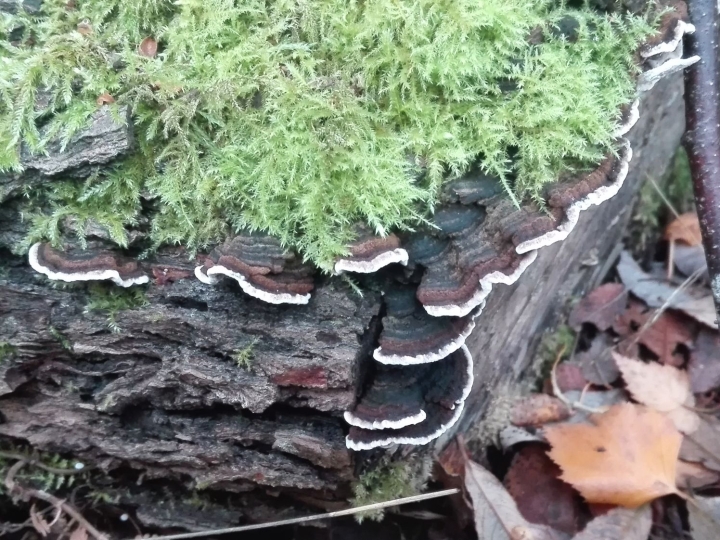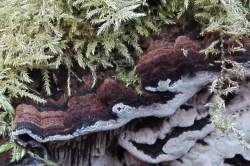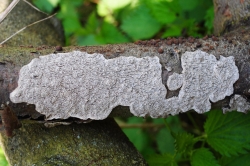A common, annual polypore on various hardwoods with wide pores and a tiny, slightly recoiling cap, but it might be resupinate too.
Home / Mushroom Guide /
Common Mazegill
Common Mazegill
| Mushroom Type | |
| Common Names |
Common Mazegill, Tagell Ddryslyd Gyffredin (CY), Żagwiak Wielkopory (PL), Hanyattfekvő Egyrétűtapló (HU) |
| Scientific Name |
Podofomes mollis |
| Synonyms |
Cerioporus mollis, Datronia mollis, Daedalea mollis |
| Season Start |
All |
| Season End |
All |
| Average Mushroom height (CM) | |
| Average Cap width (CM) |
1–6 |
Please note that each and every mushroom you come across may vary in appearance to these photos.
Fruiting Body
1–6 cm across, but many individual fruitbodies can form larger (up to 10–20 cm) patches. Mostly semi-pileate (having a recoiling, tiny cap), sometimes resupinate (laying on the substrate without forming a cap, which means only its pores are visible). The sterile (upper) surface is brown to dark brown, or even black, concentrically zoned and initially deeply furrowed (sulcate), but may become smooth and shiny with age. Pore surface pale cream or buff at first, becoming grey brown to dark brown with age. Margin thin, paler than the pore surface, roundish, sterile, and wavy.
Pores
Tubes up to 1–4 mm long, brownish. Pores 1–2 per mm, really wide, irregular, round-angular to more or less maze-like (daedaleoid), sometimes almost dentinoid with thin walls.
Flesh
0.5–1 mm thin, tough, leathery when young, hard and brittle when dry. Its upped and lower layer is separated by a very thin black line.
Habitat
On dead branches, stumps and trunks of various hardwoods, preferably (but not exclusively) on Beech, Birch, Alder and Lime. Saprotrophic, causes white-rot.
Taste / Smell
Inedible. Taste and smell not distinctive.
Frequency
Common and widespread in the UK.
Spores
Spore print is white. Spores cylindrical-ellipsoid, smooth and colourless (hyaline).
Other Facts
It was first described as Daedalea mollis by the Norvegian priest and botanist Søren Christian Sommerfelt in 1826. One of the founding fathers of modern fungal taxonomy, Elias Magnus Fries placed it to genus Trametes in 1974. It was reclassified many times ever since, and only recently (in 2020) had been placed to the genus Podofomes which was created by the Czech mycologist Zdeněk Pouzar in 1966.




























Leave a Reply